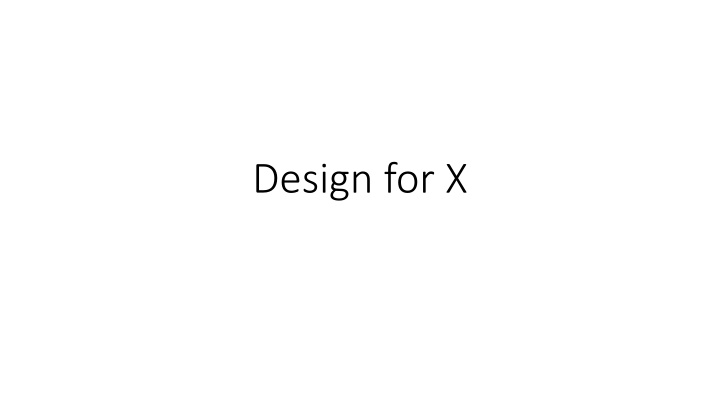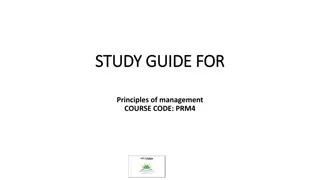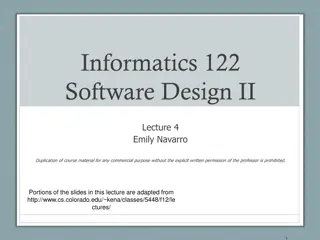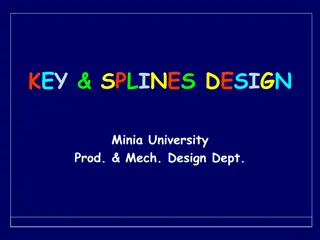Comprehensive Guide to Design for X Principles
Delve into the essential principles of Design for X (DfX) covering aspects such as manufacturability, ergonomics, safety, environment, reliability, serviceability, and retirement. Explore strategies for efficient design, validation, and testing to ensure optimal user experience and product performance.
Download Presentation

Please find below an Image/Link to download the presentation.
The content on the website is provided AS IS for your information and personal use only. It may not be sold, licensed, or shared on other websites without obtaining consent from the author.If you encounter any issues during the download, it is possible that the publisher has removed the file from their server.
You are allowed to download the files provided on this website for personal or commercial use, subject to the condition that they are used lawfully. All files are the property of their respective owners.
The content on the website is provided AS IS for your information and personal use only. It may not be sold, licensed, or shared on other websites without obtaining consent from the author.
E N D
Presentation Transcript
Design for XA Short List Design for Manufacturability Design for Ergonomics Design for Safety Design for Environment Design for Reliability Design for Serviceability Design for Retirement
Design for Ergonomics Who (User analysis demography height, weight, gender,..) How? (Task analysis) Usability? (How effectively does the proposed solution work?) Anthropometrics (Data from Military Standards) User percentiles Key parameters User friendliness User bandwidth (Flexibility) Validation and testing
Design for Ergonomics Ease of use for a large spectrum of employees (Height, weight, flexibility, etc.) Dexterity Vision (Lightings Lumen, orientation, location,..) Ease of Use (Grip, fatigue, ease of operation, etc.) Fail safe design (In case of failure ..) Standardization (Uniformity & avoidance of confusion)
Design for Manufacturability & Processability Material selection (Avoid regulated/restricted material) Shape & Size Ease of Manufacturing Avoiding failures (Frequent & catastrophic) Tolerances Minimize secondary operations
Typical DfM Design Rules 1. Space holes to be made in one operation without tooling weakness 2. Avoid generalized statements on drawings, i.e. Polish this surface. 3. Dimension from specific surfaces or points on the part 4. Dimension from a single datum to avoid tolerance stack-up 5. Design for minimum weight, within the strength and stiffness constraints 6. Whenever possible design to use general-purpose tooling 7. Use generous fillets and radii on castings, molded, formed and machined parts 8. Minimize the number of separate operations and set-u
Design for Manufacturability (Continued) Stress Material Uniformly! Bending: Inefficient Often only 1% of material carrying the max stress Tension: Great! Often 99% of material sharing the mean stress Torsion: OK
Summary of DfA (Assembly) Design with the minimum number of parts Develop a modular design Minimize part variations Design parts to be multifunctional Design parts for multiuse Design parts for ease of fabrication Avoid separate fasteners Minimize assembly directions; top-down assembly Maximize compliance, ease of assembly Minimize handling; DF handling and presentation Evaluate assembly methods Eliminate or simplify adjustments Avoid flexible components
Design for Safety Material Ergonomic features Safety features and signs Fail Safe Design Add protective devices Use EPA and OSHA approved paints & materials
Inherently Safe Design Use safer materials by substitution (Water rather detergent) Minimize hazardous materials & ensure to contain them properly Use proper signs & switches (Kill Switches) Use sensors and controls to accommodate accidental overload Use Adequate Safety Factor in your Design Simpler the Design Safer & More Reliable is the Design
Fail Safe Design Cannot operate a Microwave oven IF the door is open! Forcespinning [TM] cannot operated IF the All the Safety Features are Not in place Circuit Breakers
Design for Environment Material (Recycled, recyclable or Biodegradable materials) Maximize life expectancy Improve disposability (Redesign packaging if possible) Improve serviceability/repairability























